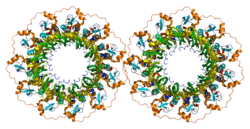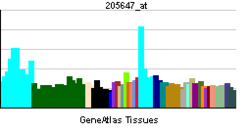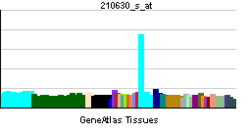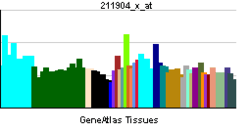RAD52
| View/Edit Human | View/Edit Mouse |
RAD52 homolog (S. cerevisiae), also known as RAD52, is a protein which in humans is encoded by the RAD52 gene.[4][5]
Function
The protein encoded by this gene shares similarity with Saccharomyces cerevisiae Rad52, a protein important for DNA double-strand break repair and homologous recombination. This gene product was shown to bind single-stranded DNA ends, and mediate the DNA-DNA interaction necessary for the annealing of complementary DNA strands. It was also found to interact with DNA recombination protein RAD51, which suggested its role in RAD51-related DNA recombination and repair.[5]
Role in DNA recombination repair
RAD52 mediates RAD51 function in homologous recombinational repair (HRR) in both yeast Saccharomyces cerevisiae and in mammalian cells of mice and humans. However, the RAD52 protein has distinctly different functions in HRR of yeast and humans. In S. cerevisae, Rad52 protein, acting alone, facilitates the loading of Rad51 protein onto single-stranded DNA pre-coated with replication protein A in the presynaptic phase of recombination.[6][7]
In mice and humans, however, BRCA2 primarily mediates orderly assembly of RAD51 on ssDNA, the form that is active for homologous pairing and strand invasion.[8] BRCA2 also redirects RAD51 from dsDNA and prevents dissociation from ssDNA.[8] In addition, the four paralogs of RAD51, consisting of RAD51B (RAD51L1), RAD51C (RAD51L2), RAD51D (RAD51L3), XRCC2 form a complex called the BCDX2 complex. This complex participates in RAD51 recruitment or stabilization at damage sites.[9] The BCDX2 complex appears to act by facilitating the assembly or stability of the RAD51 nucleoprotein filament. However, in the presence of a BRCA2 mutation, human RAD52 can mediate RAD51 assembly on ssDNA and substitute for BRCA2 in homologous recombinational DNA repair,[10] though with lower efficiency than BRCA2.
In addition, human RAD52, in combination with ERCC1, promotes the error-prone homologous DNA repair pathway of single-strand annealing.[11] Though error prone, this repair pathway may be needed for survival of cells with DNA damage that is not otherwise repairable.
Human RAD52 also has an important role in repair of DNA double-strand breaks at active transcription sites during the G0/G1 phase of the cell cycle. Repair of these double-strand breaks appears to use an RNA template-based recombination mechanism dependent on RAD52.[12] The Cockayne Syndrome B protein (CSB) (coded for by ERCC6) localizes at double-strand breaks at sites of active transcription, followed by RAD51, RAD51C and RAD52 to carry out homologous recombinational repair using the newly synthesized RNA as a template.[12]
microRNAs and cancer risk
Three prime untranslated regions (3'UTRs) of messenger RNAs (mRNAs) often contain regulatory sequences that can cause post-transcriptional RNA silencing. Such 3'-UTRs often contain binding sites for microRNAs (miRNAs). By binding to specific sites within the 3'-UTR, miRNAs can decrease gene expression of various mRNAs by either inhibiting translation or directly causing degradation of the transcript.
MicroRNAs (miRNAs) appear to regulate the expression of more than 60% of protein coding genes of the human genome.[13] One microRNA, miR-210, represses RAD52.[14] As noted by Devlin et al., miR-210 is up-regulated in most solid tumors and negatively affects the clinical outcome.[15]
The 3'-UTR of RAD52 also has a binding site for the microRNA let-7. Women with a single-nucleotide polymorphism (SNP) in the binding site for let-7 (rs7963551), that causes reduced binding of let-7, likely have increased expression of RAD52 (as was shown for this SNP in liver[16]). Women with this SNP in the 3'UTR of RAD52 showed a reduced breast cancer risk with an odds ratio of 0.84, 95% confidence interval of 0.75-0.95.[17]
In a Han Chinese population, the same SNP as above in the 3'-UTR of RAD52 binding site for let-7 (rs7963551) reduced the risk of glioma. The risk of glioma associated with the RAD52 rs7963551 genotype had an odds ratio (compared to those without the SNP) of 0.44 for those older than 41 years, and an odds ratio of 0.58 for those 41 years or younger.[18]
Li et al.[16] found significantly decreased hepatic cellular carcinoma risk among individuals with the RAD52 rs7963551 CC genotype (the same SNP as above) compared with those with the AA genotype in a Chinese population. They also found that in 44 normal human liver tissue samples, presence of the rs7963551 SNP was associated with a significant increase of RAD52 mRNA expression.
Thus increased RAD52 expression is protective against various cancers.
Another study of altered microRNA binding sites in RAD52 and their effects on cancer susceptibility was carried out by Naccarati et al.[19] They found two RAD52 microRNA binding sites that were frequently altered and had an effect on colon cancer risk. Individuals with a homozygous or heterozygous SNP in rs1051669 were at increased risk of colon cancer (OR 1.78, 95% CI 1.13–2.80, p = 0.01 for homozygotes and OR 1.72, 95% CI 1.10–2.692, p = 0.02 for heterozygotes). Heterozygous carriers of the other RAD52 SNP (rs11571475) were at decreased risk of colon cancer (OR 0.76, 95% CI 0.58–1.00, p = 0.05). Of 21 genes in the homologous recombinational repair pathway and 7 genes in the non-homologous end joining pathway examined, the only SNPs found in microRNA binding regions which were both at high enough frequency to evaluate and which affected risks of colon cancer, were the two in RAD52 and one in MRE11A.
DNA damage appears to be the primary underlying cause of cancer,[20][21] and deficiencies in DNA repair appear to underlie many forms of cancer.[22] If DNA repair is deficient, DNA damage tends to accumulate. Such excess DNA damage may increase mutational errors during DNA replication due to error-prone translesion synthesis. Excess DNA damage may also increase epigenetic alterations due to errors during DNA repair.[23][24] Such mutations and epigenetic alterations may give rise to cancer. The frequent microRNA-induced increase or deficiency of RAD52-mediated DNA repair due to microRNA binding alterations likely contributes to either the prevention or progression of breast, brain, liver or colon cancers.
Interactions
RAD52 has been shown to interact with RAD51.[25] The Rad52 will ease the loading of Rad51 on ssDNA by interfering with the RPA protein.
References
- ↑ "Diseases that are genetically associated with RAD52 view/edit references on wikidata".
- ↑ "Human PubMed Reference:".
- ↑ "Mouse PubMed Reference:".
- ↑ Shen Z, Denison K, Lobb R, Gatewood JM, Chen DJ (Jan 1995). "The human and mouse homologs of the yeast RAD52 gene: cDNA cloning, sequence analysis, assignment to human chromosome 12p12.2-p13, and mRNA expression in mouse tissues". Genomics. 25 (1): 199–206. doi:10.1016/0888-7543(95)80126-7. PMID 7774919.
- 1 2 "Entrez Gene: RAD52 RAD52 homolog (S. cerevisiae)".
- ↑ Shinohara A, Ogawa T (1998). "Stimulation by Rad52 of yeast Rad51-mediated recombination". Nature. 391 (6665): 404–7. doi:10.1038/34943. PMID 9450759.
- ↑ New JH, Sugiyama T, Zaitseva E, Kowalczykowski SC (1998). "Rad52 protein stimulates DNA strand exchange by Rad51 and replication protein A". Nature. 391 (6665): 407–10. doi:10.1038/34950. PMID 9450760.
- 1 2 Holloman WK (2011). "Unraveling the mechanism of BRCA2 in homologous recombination". Nat. Struct. Mol. Biol. 18 (7): 748–54. doi:10.1038/nsmb.2096. PMC 3647347
 . PMID 21731065.
. PMID 21731065. - ↑ Chun J, Buechelmaier ES, Powell SN (2013). "Rad51 paralog complexes BCDX2 and CX3 act at different stages in the BRCA1-BRCA2-dependent homologous recombination pathway". Mol. Cell. Biol. 33 (2): 387–95. doi:10.1128/MCB.00465-12. PMC 3554112
 . PMID 23149936.
. PMID 23149936. - ↑ Feng Z, Scott SP, Bussen W, Sharma GG, Guo G, Pandita TK, Powell SN (2011). "Rad52 inactivation is synthetically lethal with BRCA2 deficiency". Proc. Natl. Acad. Sci. U.S.A. 108 (2): 686–91. doi:10.1073/pnas.1010959107. PMC 3021033
 . PMID 21148102.
. PMID 21148102. - ↑ Stark JM, Pierce AJ, Oh J, Pastink A, Jasin M (2004). "Genetic steps of mammalian homologous repair with distinct mutagenic consequences". Mol. Cell. Biol. 24 (21): 9305–16. doi:10.1128/MCB.24.21.9305-9316.2004. PMC 522275
 . PMID 15485900.
. PMID 15485900. - 1 2 Wei L, Nakajima S, Böhm S, Bernstein KA, Shen Z, Tsang M, Levine AS, Lan L (2015). "DNA damage during the G0/G1 phase triggers RNA-templated, Cockayne syndrome B-dependent homologous recombination". Proc. Natl. Acad. Sci. U.S.A. 112 (27): E3495–504. doi:10.1073/pnas.1507105112. PMC 4500203
 . PMID 26100862.
. PMID 26100862. - ↑ Friedman RC, Farh KK, Burge CB, Bartel DP (2009). "Most mammalian mRNAs are conserved targets of microRNAs". Genome Res. 19 (1): 92–105. doi:10.1101/gr.082701.108. PMC 2612969
 . PMID 18955434.
. PMID 18955434. - ↑ Crosby ME, Kulshreshtha R, Ivan M, Glazer PM (2009). "MicroRNA regulation of DNA repair gene expression in hypoxic stress". Cancer Res. 69 (3): 1221–9. doi:10.1158/0008-5472.CAN-08-2516. PMC 2997438
 . PMID 19141645.
. PMID 19141645. - ↑ Devlin C, Greco S, Martelli F, Ivan M (2011). "miR-210: More than a silent player in hypoxia". IUBMB Life. 63 (2): 94–100. doi:10.1002/iub.427. PMC 4497508
 . PMID 21360638.
. PMID 21360638. - 1 2 Li Z, Guo Y, Zhou L, Ge Y, Wei L, Li L, Zhou C, Wei J, Yuan Q, Li J, Yang M (2015). "Association of a functional RAD52 genetic variant locating in a miRNA binding site with risk of HBV-related hepatocellular carcinoma". Mol. Carcinog. 54 (9): 853–8. doi:10.1002/mc.22156. PMID 24729511.
- ↑ Jiang Y, Qin Z, Hu Z, Guan X, Wang Y, He Y, Xue J, Liu X, Chen J, Dai J, Jin G, Ma H, Wang S, Shen H (2013). "Genetic variation in a hsa-let-7 binding site in RAD52 is associated with breast cancer susceptibility". Carcinogenesis. 34 (3): 689–93. doi:10.1093/carcin/bgs373. PMID 23188672.
- ↑ Lu C, Chen YD, Han S, Wei J, Ge Y, Pan W, Jiang T, Qiu XG, Yang M (2014). "A RAD52 genetic variant located in a miRNA binding site is associated with glioma risk in Han Chinese". J. Neurooncol. 120 (1): 11–7. doi:10.1007/s11060-014-1527-x. PMID 25012956.
- ↑ Naccarati A, Rosa F, Vymetalkova V, Barone E, Jiraskova K, Di Gaetano C, Novotny J, Levy M, Vodickova L, Gemignani F, Buchler T, Landi S, Vodicka P, Pardini B (2015). "Double-strand break repair and colorectal cancer: gene variants within 3' UTRs and microRNAs binding as modulators of cancer risk and clinical outcome". Oncotarget. doi:10.18632/oncotarget.6804. PMID 26735576.
- ↑ Kastan MB (2008). "DNA damage responses: mechanisms and roles in human disease: 2007 G.H.A. Clowes Memorial Award Lecture". Mol. Cancer Res. 6 (4): 517–24. doi:10.1158/1541-7786.MCR-08-0020. PMID 18403632.
- ↑ Bernstein C, Prasad AR, Nfonsam V, Bernstein H. (2013). DNA Damage, DNA Repair and Cancer, New Research Directions in DNA Repair, Prof. Clark Chen (Ed.), ISBN 978-953-51-1114-6, InTech, http://www.intechopen.com/books/new-research-directions-in-dna-repair/dna-damage-dna-repair-and-cancer
- ↑ Harper JW, Elledge SJ (2007). "The DNA damage response: ten years after". Mol. Cell. 28 (5): 739–45. doi:10.1016/j.molcel.2007.11.015. PMID 18082599.
- ↑ O'Hagan HM, Mohammad HP, Baylin SB (2008). "Double strand breaks can initiate gene silencing and SIRT1-dependent onset of DNA methylation in an exogenous promoter CpG island". PLoS Genetics. 4 (8): e1000155. doi:10.1371/journal.pgen.1000155. PMC 2491723
 . PMID 18704159.
. PMID 18704159. - ↑ Cuozzo C, Porcellini A, Angrisano T, Morano A, Lee B, Di Pardo A, Messina S, Iuliano R, Fusco A, Santillo MR, Muller MT, Chiariotti L, Gottesman ME, Avvedimento EV (Jul 2007). "DNA damage, homology-directed repair, and DNA methylation". PLoS Genetics. 3 (7): e110. doi:10.1371/journal.pgen.0030110. PMC 1913100
 . PMID 17616978.
. PMID 17616978. - ↑ Chen G, Yuan SS, Liu W, Xu Y, Trujillo K, Song B, Cong F, Goff SP, Wu Y, Arlinghaus R, Baltimore D, Gasser PJ, Park MS, Sung P, Lee EY (Apr 1999). "Radiation-induced assembly of Rad51 and Rad52 recombination complex requires ATM and c-Abl". The Journal of Biological Chemistry. 274 (18): 12748–52. doi:10.1074/jbc.274.18.12748. PMID 10212258.
Further reading
- Muris DF, Bezzubova O, Buerstedde JM, Vreeken K, Balajee AS, Osgood CJ, Troelstra C, Hoeijmakers JH, Ostermann K, Schmidt H (Nov 1994). "Cloning of human and mouse genes homologous to RAD52, a yeast gene involved in DNA repair and recombination". Mutation Research. 315 (3): 295–305. doi:10.1016/0921-8777(94)90040-x. PMID 7526206.
- Shen Z, Denison K, Lobb R, Gatewood JM, Chen DJ (Jan 1995). "The human and mouse homologs of the yeast RAD52 gene: cDNA cloning, sequence analysis, assignment to human chromosome 12p12.2-p13, and mRNA expression in mouse tissues". Genomics. 25 (1): 199–206. doi:10.1016/0888-7543(95)80126-7. PMID 7774919.
- Park MS (Jun 1995). "Expression of human RAD52 confers resistance to ionizing radiation in mammalian cells". The Journal of Biological Chemistry. 270 (26): 15467–70. doi:10.1074/jbc.270.26.15467. PMID 7797537.
- Shen Z, Pardington-Purtymun PE, Comeaux JC, Moyzis RK, Chen DJ (Sep 1996). "UBL1, a human ubiquitin-like protein associating with human RAD51/RAD52 proteins". Genomics. 36 (2): 271–9. doi:10.1006/geno.1996.0462. PMID 8812453.
- Shen Z, Pardington-Purtymun PE, Comeaux JC, Moyzis RK, Chen DJ (Oct 1996). "Associations of UBE2I with RAD52, UBL1, p53, and RAD51 proteins in a yeast two-hybrid system". Genomics. 37 (2): 183–6. doi:10.1006/geno.1996.0540. PMID 8921390.
- Chen G, Yuan SS, Liu W, Xu Y, Trujillo K, Song B, Cong F, Goff SP, Wu Y, Arlinghaus R, Baltimore D, Gasser PJ, Park MS, Sung P, Lee EY (Apr 1999). "Radiation-induced assembly of Rad51 and Rad52 recombination complex requires ATM and c-Abl". The Journal of Biological Chemistry. 274 (18): 12748–52. doi:10.1074/jbc.274.18.12748. PMID 10212258.
- Kito K, Wada H, Yeh ET, Kamitani T (Dec 1999). "Identification of novel isoforms of human RAD52". Biochimica et Biophysica Acta. 1489 (2-3): 303–14. doi:10.1016/s0167-4781(99)00214-6. PMID 10673031.
- Stasiak AZ, Larquet E, Stasiak A, Müller S, Engel A, Van Dyck E, West SC, Egelman EH (Mar 2000). "The human Rad52 protein exists as a heptameric ring". Current Biology. 10 (6): 337–40. doi:10.1016/S0960-9822(00)00385-7. PMID 10744977.
- Parsons CA, Baumann P, Van Dyck E, West SC (Aug 2000). "Precise binding of single-stranded DNA termini by human RAD52 protein". The EMBO Journal. 19 (15): 4175–81. doi:10.1093/emboj/19.15.4175. PMC 306603
 . PMID 10921897.
. PMID 10921897. - Mer G, Bochkarev A, Gupta R, Bochkareva E, Frappier L, Ingles CJ, Edwards AM, Chazin WJ (Oct 2000). "Structural basis for the recognition of DNA repair proteins UNG2, XPA, and RAD52 by replication factor RPA". Cell. 103 (3): 449–56. doi:10.1016/S0092-8674(00)00136-7. PMID 11081631.
- Ranatunga W, Jackson D, Flowers II RA, Borgstahl GE (Jul 2001). "Human RAD52 protein has extreme thermal stability". Biochemistry. 40 (29): 8557–62. doi:10.1021/bi0155089. PMID 11456495.
- Van Dyck E, Stasiak AZ, Stasiak A, West SC (Oct 2001). "Visualization of recombination intermediates produced by RAD52-mediated single-strand annealing". EMBO Reports. 2 (10): 905–9. doi:10.1093/embo-reports/kve201. PMC 1084079
 . PMID 11571269.
. PMID 11571269. - Kim PM, Allen C, Wagener BM, Shen Z, Nickoloff JA (Nov 2001). "Overexpression of human RAD51 and RAD52 reduces double-strand break-induced homologous recombination in mammalian cells". Nucleic Acids Research. 29 (21): 4352–60. doi:10.1093/nar/29.21.4352. PMC 60192
 . PMID 11691922.
. PMID 11691922. - Yáñez RJ, Porter AC (Feb 2002). "Differential effects of Rad52p overexpression on gene targeting and extrachromosomal homologous recombination in a human cell line". Nucleic Acids Research. 30 (3): 740–8. doi:10.1093/nar/30.3.740. PMC 100286
 . PMID 11809887.
. PMID 11809887. - Jackson D, Dhar K, Wahl JK, Wold MS, Borgstahl GE (Aug 2002). "Analysis of the human replication protein A:Rad52 complex: evidence for crosstalk between RPA32, RPA70, Rad52 and DNA". Journal of Molecular Biology. 321 (1): 133–48. doi:10.1016/S0022-2836(02)00541-7. PMID 12139939.
- Kagawa W, Kurumizaka H, Ishitani R, Fukai S, Nureki O, Shibata T, Yokoyama S (Aug 2002). "Crystal structure of the homologous-pairing domain from the human Rad52 recombinase in the undecameric form". Molecular Cell. 10 (2): 359–71. doi:10.1016/S1097-2765(02)00587-7. PMID 12191481.
- Singleton MR, Wentzell LM, Liu Y, West SC, Wigley DB (Oct 2002). "Structure of the single-strand annealing domain of human RAD52 protein". Proceedings of the National Academy of Sciences of the United States of America. 99 (21): 13492–7. doi:10.1073/pnas.212449899. PMC 129701
 . PMID 12370410.
. PMID 12370410. - Liu J, Meng X, Shen Z (Oct 2002). "Association of human RAD52 protein with transcription factors". Biochemical and Biophysical Research Communications. 297 (5): 1191–6. doi:10.1016/S0006-291X(02)02353-7. PMID 12372413.
- Han J, Hankinson SE, De Vivo I, Colditz GA, Hunter DJ (Oct 2002). "No association between a stop codon polymorphism in RAD52 and breast cancer risk". Cancer Epidemiology, Biomarkers & Prevention. 11 (10 Pt 1): 1138–9. PMID 12376524.
- Kitao H, Yuan ZM (Dec 2002). "Regulation of ionizing radiation-induced Rad52 nuclear foci formation by c-Abl-mediated phosphorylation". The Journal of Biological Chemistry. 277 (50): 48944–8. doi:10.1074/jbc.M208151200. PMID 12379650.





